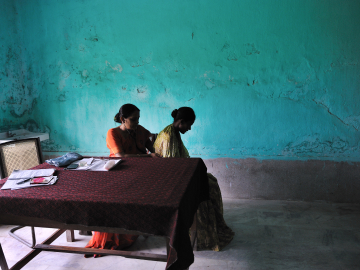Michele Barry: The Need for More Women Leaders in Global Health
Michele Barry’s verdict on the Women Leaders in Global Health conference that brought more than 400 women to Stanford last fall?
“It was kick-ass great.”
The conference and future ones are just the start to bringing more women into leadership positions in global health, says Barry, MD, the director of the Center for Innovation in Global Health and a senior associate dean at Stanford University School of Medicine. Barry distills the need this way: While global health classes are up to 70 or 80% women, leadership positions in health ministries or academia held by women are closer to 25%.
In this 2nd part of her Q&A with Global Health NOW, Barry discusses the Women Leaders in Global Health conference’s origins, future priorities and how to fix “leaks” in the pipeline of promising young women leaders heading to top leadership positions.
Read part I here.
I want to ask you about the October conference you had here, Women Leaders in Global Health, and why—
It was kick-ass great. Sorry. And don't expunge my word.
Noted.
We had over 400 women, 68 countries, 250 organizations. We were able to raise enough money to give financial aid to almost 70 women from around the world at the emerging leader level, what we're calling the mezzanine level. Not the glass ceiling or glass cliff, however you want to think of it. It was fantastic, I mean, I was tearful during some of it, when I had some of those young emerging leaders come up and say why gender mattered to them.
Why did you feel this was important to do, for Stanford to do this?
Why? It happened in Nairobi. I was at a MEPI meeting, and I was in the audience. And it was predominantly all my colleagues from Africa. It was how Africa was going to go into the future with medical education. And I looked at the podium, and they were all black men instead of all white men. Along with Francis Collins. And so, I literally sat there, I was sitting next to Wafaa El-Sadr from Columbia, and I said, I can't believe this, this is all happening all over again. And I basically got up there, and I made a very polite comment that it behooves you to think about the future. Look who's on your podium. You might want to add some women to your podium. And I literally got a standing ovation from the women in the audience. And so, I went up to Francis Collins afterwards and I said, listen, we need to do something about this. And he said he'd give me money if I could think of some way to approach the problem. And so that's where the movement kind of started.
And it's not just about conferences. We're continuing this forward. We have a steering committee that brainstormed ways to actually bring forth a call to action, which published in The Lancet in November. The London School of Tropical Medicine is having the next conference. And then the year after that, Agnes Binagwaho is holding it in Rwanda. And in between, we're continuing to keep a community discussion going, about how to make inroads into gender parity. We'd like to get a lot of good men there. There were only 20 brave men that came to this conference. And five of them were on a panel—on men who engage. And the other one was my husband.
This is a tough problem, right?
I hope this is a game changer. I hope this conference was a game changer. And I really hope that folks take to heart our call to action. And these are very simple steps that people can take, to make a difference. Whether they're in a society, or planning a conference. Or instead of mentoring a woman, actually sponsoring a woman. There's a difference. When you put someone up for something rather than just do mentorship. We have all kinds of interesting suggestions that came out of this conference.
I was just sitting in one of your group's lab meetings, and they were talking about this issue of that imbalance between number of women going into global health versus—
Oh, it's become a feminized. The academy has become feminized, as well as NGOs. And if you think of—
But leadership hasn't.
No, leadership has not. 25% of ministers are women. And in my peer to peer deans’ groups, it's less than, I think it's like 25% are women. So, it's certainly not equal at all. Oh, and then we also looked at health care sector CEOs. 26 out of 27 are male.
And why is that, because, as somebody in this lab meeting pointed out, obviously the student ratio is probably 60% women or something like that.
It's more like 70 to 80% women, in my classes.
One of the people said that everybody assumed that, “Okay, well it's just a matter of time that this will be reflected in terms of leadership.” But it's not actually-
I've heard that story now for many, many decades. That we're all in the pipeline. Well, I have news for you. The pipeline has major leaks. And I think where it leaks mostly is in the mezzanine level. You know, that mid-level. And I think there are many reasons for that. But I think we need good studies to figure out why that's happening.
Any thought on why—
Yeah, I have thoughts about that. And Jennifer Downs at Cornell has written a nice paper about that, where she discusses some of the issues of family-career integration. How difficult that is. When you're living overseas and working overseas. To take a leadership position. There are a whole set of why I think there's stereotype bias. I mean, I think there's gender bias. I'm going to be frankly out there and say there's gender bias for leadership positions.
Join the tens of thousands of subscribers who rely on Global Health NOW summaries and exclusive articles for the latest public health news. Sign up for our free weekday enewsletter, and please share the link with friends and colleagues.
Michele Barry presents at the inaugural Women Leader in Global Health conference at Stanford in October 2017 (Image credit: Rod Searcey / Stanford Medicine)





